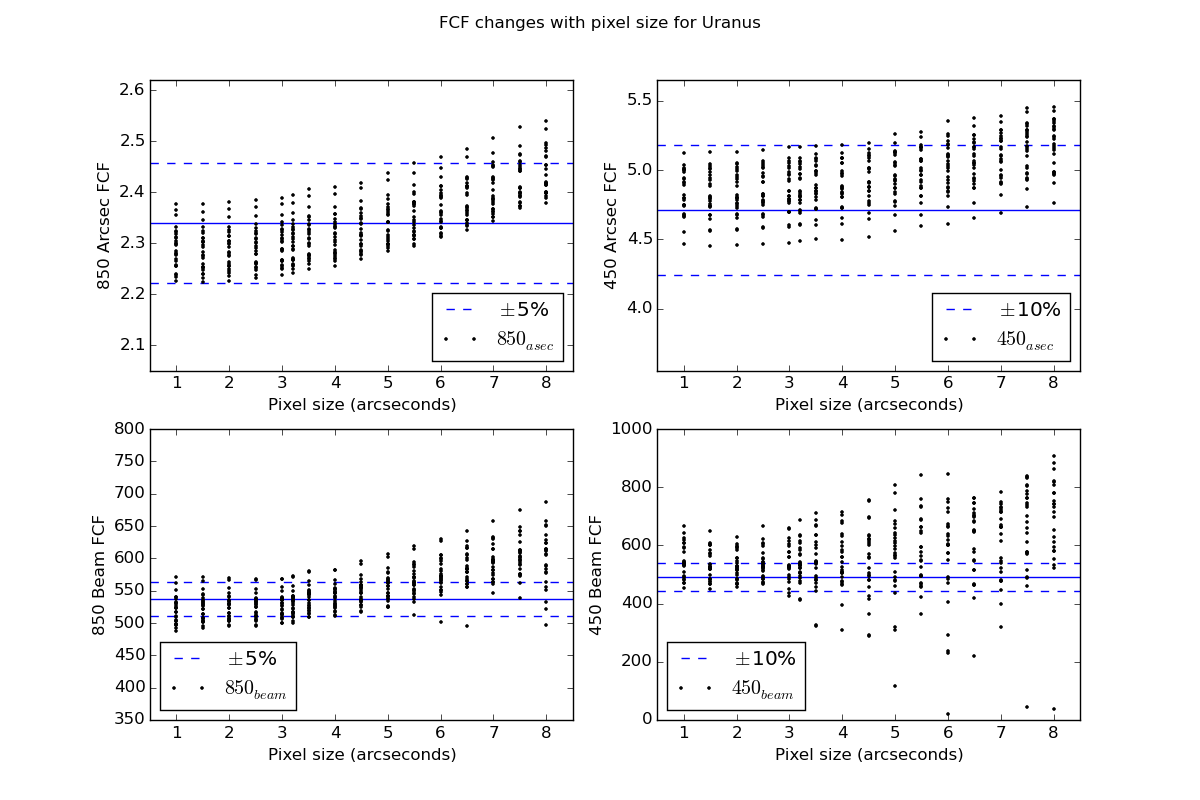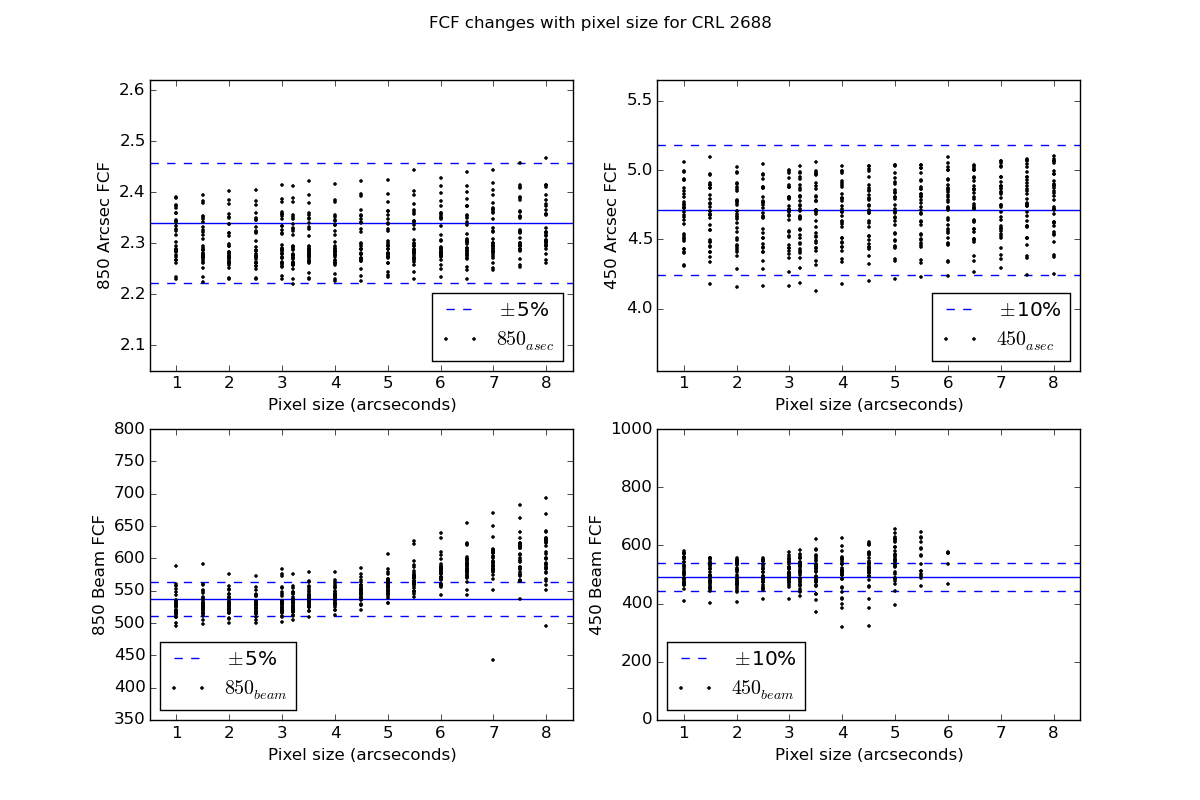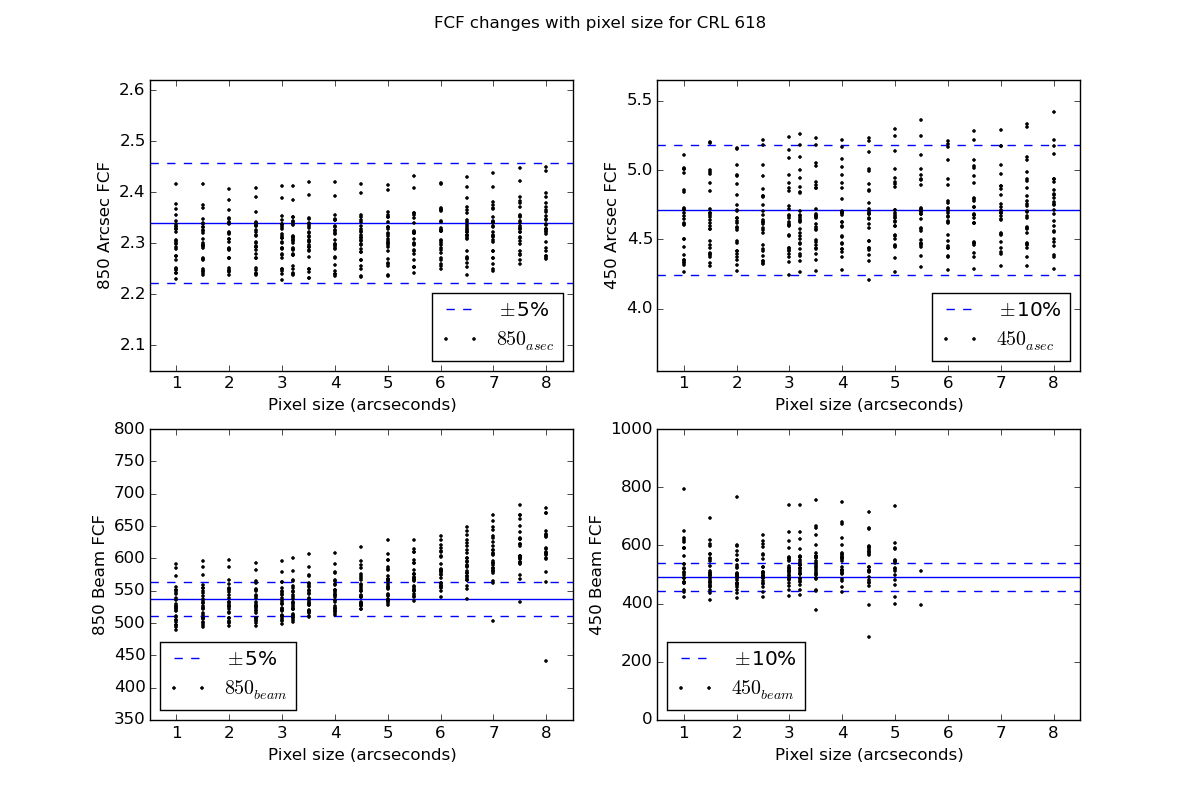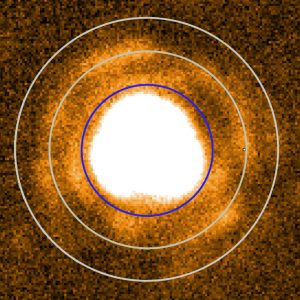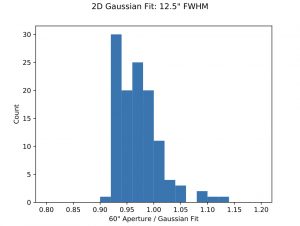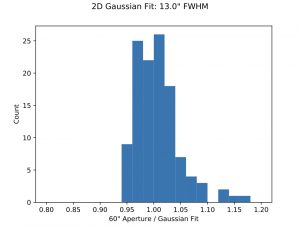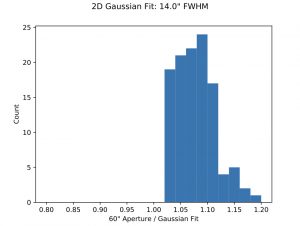Contents
FCFs
The FCF (Flux Conversion Factor), is the value needed to convert data from pW to Jy. The FCF is calculated by observing one of our ‘calibrators’, which are bright point-sources having well-known flux densities. Our primary calibrators are Mars and Uranus; see also our list of secondary calibrators (most commonly used are CRL2688, CRL618, and Arp220).
There are two types of FCF value, and the one you will want to apply to your own data depends on what you intend to do with the data i.e. investigate surface-brightness/perform aperture photometry as opposed to measuring absolute peak flux densities.
- The peak (or beam) FCF:
Units: Jy/pW/beam
This FCF is the number by which to multiply your map if you wish to measure absolute peak fluxes of discrete sources. - The aperture (or arcsecond) FCF:
Units: Jy/pW/arcsec2
This FCF is the factor by which to multiply your map if you wish to use the calibrated map to do aperture photometry.
Studying this calibrator data over several years has shown that the mean/median values are consistent over time with the exception of periods of time affected by hardware changes to the instrument. Therefore, we recommend using the standard FCF values listed below to calibrate your data.
Standard FCF and Opacity (Tau) values
Due to a new study on the FCFs throughout SCUBA-2’s history (Mairs et al 2021), the historical standard values are subject to change in the 2021A Starlink release (release date 2021-12-27).
Three changes have affected the FCFs:
- New opacity relations have been derived at 450 and 850 microns. The opacity relation informs the extinction correction that is applied to the raw data which, in turn is used to derive the FCFs. The preliminary new FCFs listed below assume the new corrections have been applied.
- In November, 2016, SCUBA-2 underwent hardware changes (a filter set was changed). This caused a decrease in the FCFs at 850 microns while the 450 micron data was unaffected.
- In May/June, 2018, the Secondary Mirror underwent heavy maintenance. This improved the concentration of the flux within the beam, altering the FCFs.
Below are the recommended values to use on both archival and new data along with instructions on how to manually apply these changes to your data before they are adopted into the next Starlink release (TBD).
Note on the Extinction Correction/Opacity Relations
Note: Archival SCUBA-2 data should always be reduced with the latest STARLINK release.
As of the Starlink 2018A release, the software applies the following extinction corrections to SCUBA-2 data:
Extinction Correction = 1/exp(-Tau_freq x Airmass)
Where Tau_freq is the opacity at the given frequency, freq (these are called the Opacity Relations):
(Original 450 microns)
Tau_666 = 26.0 x (Tau_225 – 0.012)
(Original 850 microns)
Tau_345 = 4.6 x (Tau_225 – 0.0043)
Improved opacity relations were derived for each wavelength (Mairs et al 2021), including a higher order (non-linear) term:
(New 450 microns)
Tau_666 = 23.3 x (Tau_225 – 0.018 + 0.05 x sqrt(Tau_225))
(New 850 microns)
Tau_345 = 3.7 x [Tau_225 – 0.04 + 0.2 x sqrt(Tau_225)]
Tau_225 is the opacity at 225 GHz (See: Dempsey et al. 2013 and Mairs et al 2021) as measured by the JCMT’s WVM. The Tau_225 associated with the start and end your observations can be found in the fits header values WVMTAUST and WVMTAUEN, respectively. Similarly, the airmass information at the start and end of your observations can be found in the fits header values AMSTART and AMEND. More information regarding the weather on Maunakea can be found on the JCMT’s weather page.
In order to apply the preliminary FCFs presented below to data that was reduced by the current version of Starlink’s data reduction software, you must:
1. Multiply your data by exp(-Tau_freq x Airmass), substituting the ORIGINAL opacity relations in for Tau_freq
2. Divide your data by exp(-Tau_freq x Airmass), substituting the NEW opacity relations in for Tau_freq.
This change will affect 450 micron data obtained in very dry conditions and 850 micron data obtained in very wet conditions by up to 5%:
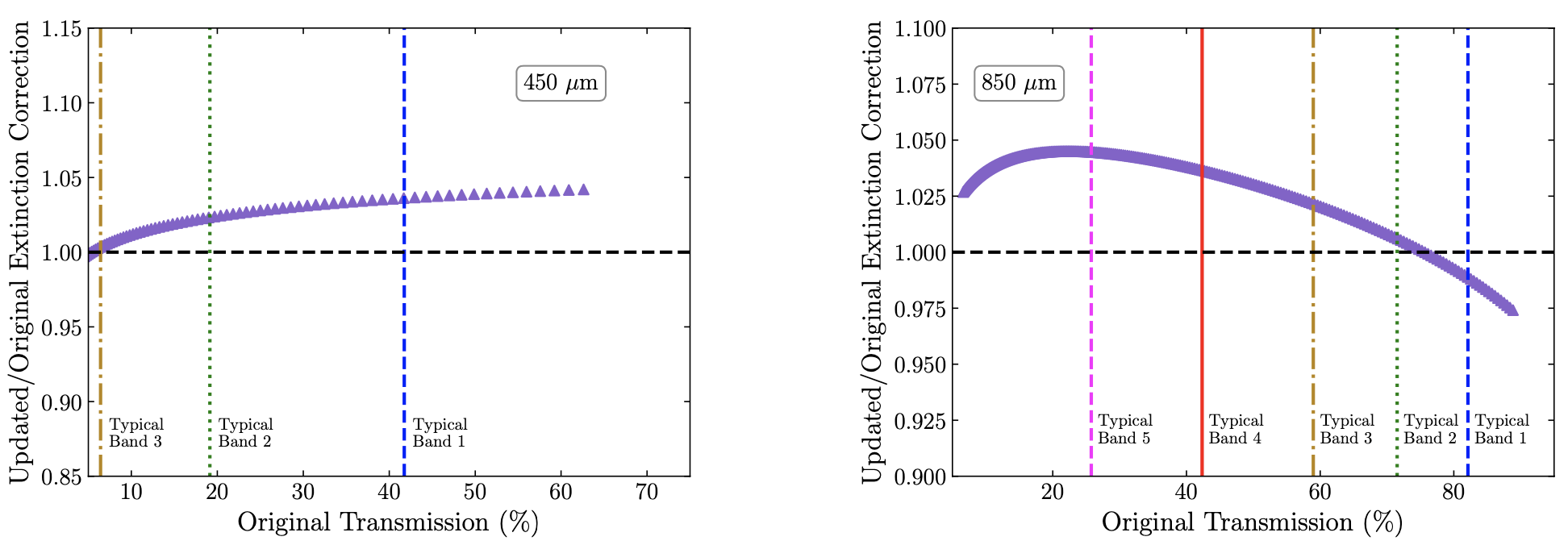
The figure above shows the newly derived extinction corrections divided by the original extinction corrections as a function of atmospheric transmission. Vertical lines show the transmission of the typical JCMT weather bands at each wavelength, assuming an airmass of 1.2. Left: 450 μm. Right: 850 μm. At 450 μm, the original opacity relation is modified by a maximum of 5% in very dry weather while at 850 μm the original opacity relation is modified by a maximum of 5% in very dry or very wet conditions. The majority of 850 μm observations, however, require no modification from the original results
Standard FCFs Employing New Extinction Correction
The values quoted below are derived from reductions of daisy maps of our calibrators using the MAKEMAP routine from SMURF, reduced with the ‘bright_compact’ dimmconfig file onto output maps with pixel size = 1 arcsec. Note that the FCF’s below have been derived for a pixel size of 1 arcsec at both 450 and 850 micron. For information on how FCFs change with pixel size, see: FCFs by Pixel Size
The scale of emission recovery is limited by the data reduction procedure that seeks to remove large-scale atmospheric contributions to the signal. On scales of ∼400 arcsec to 600 arcsec and larger (depending on the external mask boundaries), significant structures are recovered but in many cases with diminished sizes and total fluxes due to the subtraction of large-scale modes – see Mairs et al. 2015 for more quantitative details.
Before November 1st, 2016
| 450 μm FCF | 850 μm FCF | |
| Beam | 531 +/- 93 Jy beam−1 pW−1 | 525 +/- 37 Jy beam−1 pW−1 |
| Arcsec | 4.61 +/- 0.60 Jy pW−1 arcsec−2 | 2.25 +/- 0.13 Jy pW−1 arcsec−2 |
After November 1st, 2016 and Before June 30, 2018
| 450 μm FCF | 850 μm FCF | |
| Beam | 531 +/- 93 Jy beam−1 pW−1 | 516 +/- 42 Jy beam−1 pW−1 |
| Arcsec | 4.61 +/- 0.60 Jy pW−1 arcsec−2 | 2.13 +/- 0.12 Jy pW−1 arcsec−2 |
After June 30th, 2018
| 450 μm FCF | 850 μm FCF | |
| Beam | 472 +/- 76 Jy beam−1 pW−1 | 495 +/- 32 Jy beam−1 pW−1 |
| Arcsec | 3.87 +/- 0.53 Jy pW−1 arcsec−2 | 2.07 +/- 0.12 Jy pW−1 arcsec−2 |
These FCFs were derived from regular calibrator observations spanning May 1st, 2011 to February 10th, 2021. The figures below summarise the table presented above:
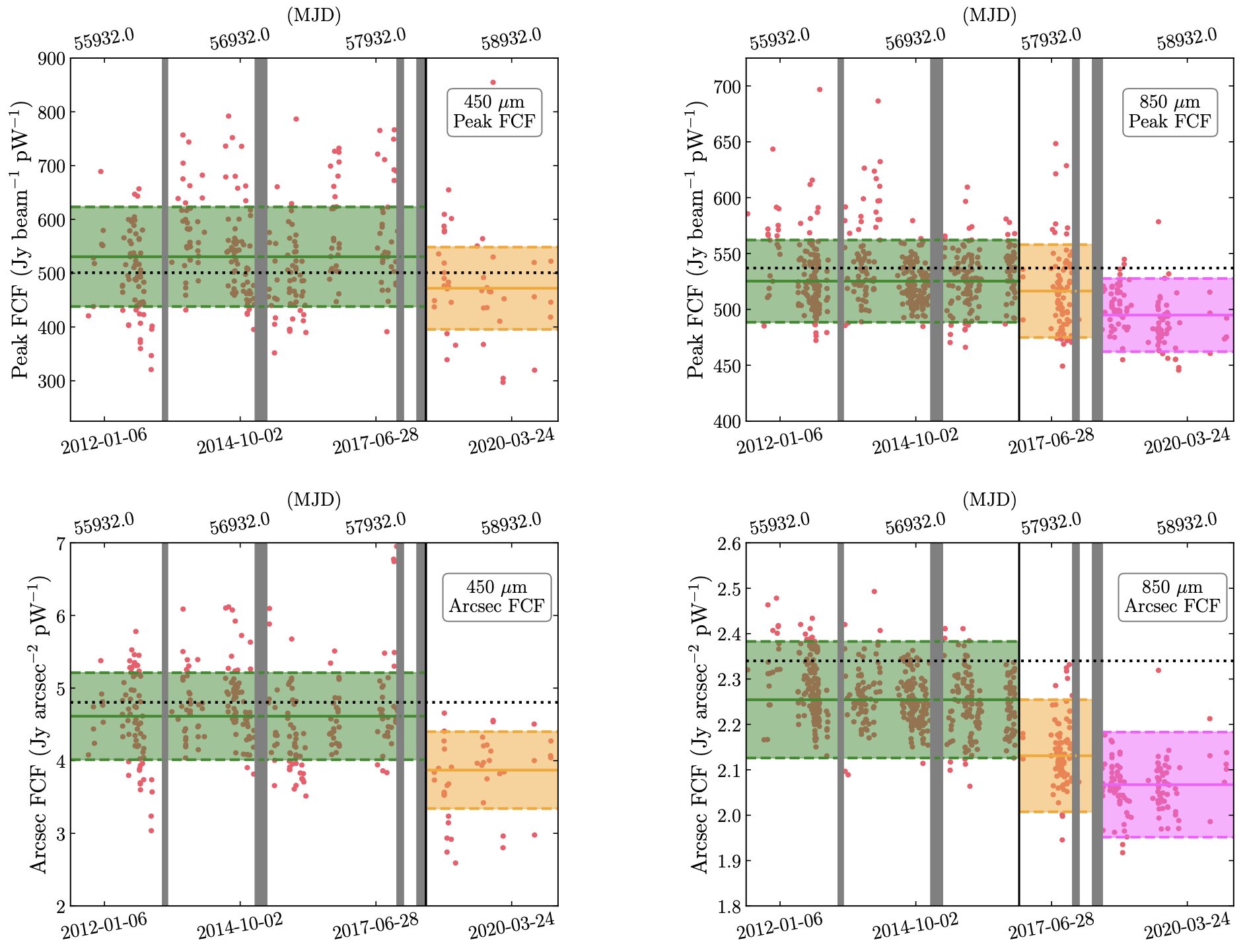
The figures above (Mairs et al 2021) show flux conversion factors (FCFs) derived using flux measurements of the primary calibrator Uranus during the stable part of the night (07:00-17:00 UT, 21:00-07:00 HST) as a function of date. The gray shaded regions indicate epochs that are not included in the FCF determinations. The horizontal, shaded regions indicate the median FCF value over each span of time and the associated standard deviation. The black (dotted) lines indicate the original FCF value derived by Dempsey et al 2013, adjusted for the newly derived opacity relation, assuming the most common atmospheric transmissions during observations. Left: Peak (Top) and Arcsecond (Bottom) FCFs derived at 450 μm. The solid, vertical line at the right edge of the latest gray region marks 2018 June 30, when the secondary-mirror malfunction was fixed. Data wherein the atmospheric transmission are less than 10% are excluded. Right: Peak (Top) and Arcsecond (Bottom) FCFs derived at 850 μm. The solid, vertical line marks 2016 Nov 19 when the SCUBA-2 thermal filter stack was updated. Data wherein the atmospheric transmission are less than 25% are excluded.
Daily Changes in FCF
The figures below (Mairs et al 2021) show the Peak FCFs at 450 and 850 micron as a function of UT time for observations of Uranus, CRL 2688, and CRL 618. The Peak FCF is larger in the evening and morning primarily because thermal deformations of the dish dilute the flux from the main beam into the secondary (error) component. There is no significant change to the Arcsecond FCFs in the early evening or late morning.
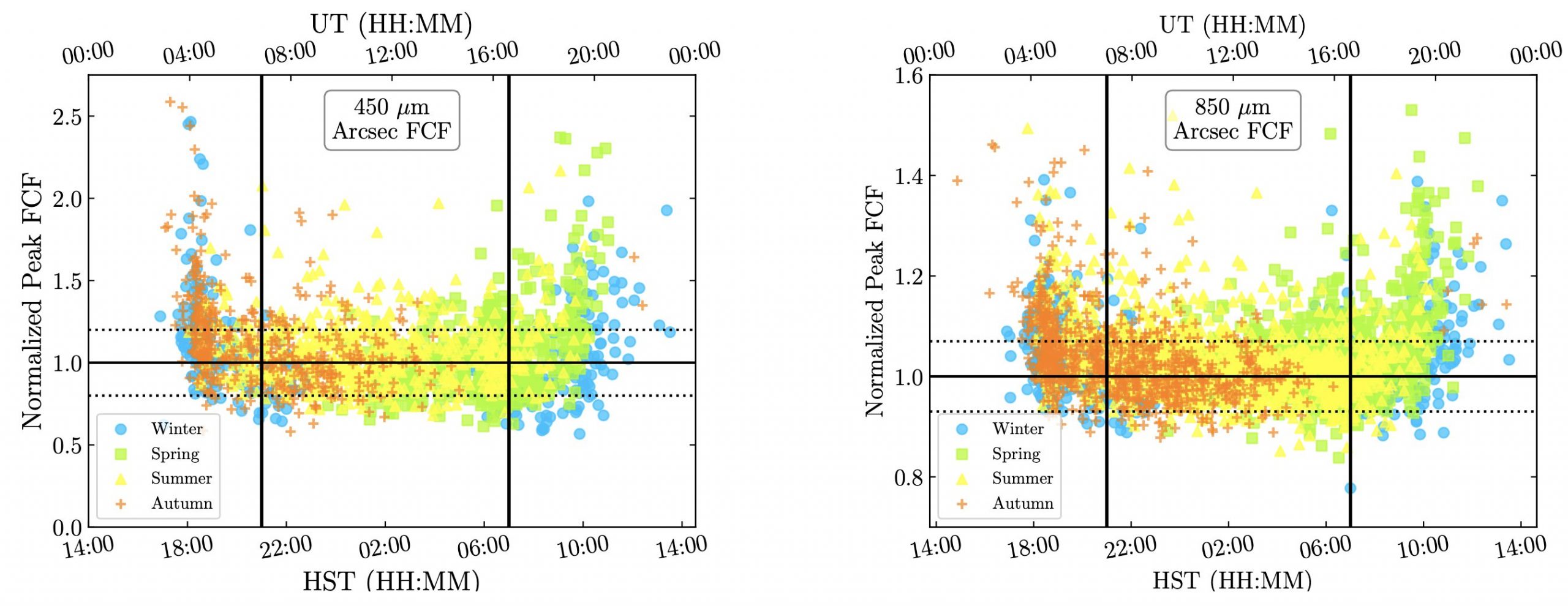
The figures above show the Normalized Peak FCFs at 450 (left) and 850 μm (right) as a function of observation time. All FCFs are derived using the primary calibrator Uranus and secondary calibrator CRL 2688. The vertical lines mark the beginning and end of the “stable” observation period from 07:00–17:00 (UTC), or, 21:00-07:00 (HST). The horizontal (dotted) lines show the FCF uncertainties derived for the stable observation period around a value of 1.0 (horizontal, solid line). Data are coloured according to season: blue circles represent Winter, green squares represent Spring, yellow triangles represent Summer, and orange crosses represent Autumn. There are no significant trends with the time of year.
The figures below show the Peak FCF trends in detail for evening, night, and morning observations of Uranus and CRL 2688. The data are bootstrap-fit with linear functions and “rs” indicated the Spearman-Rank correlation of the fit:
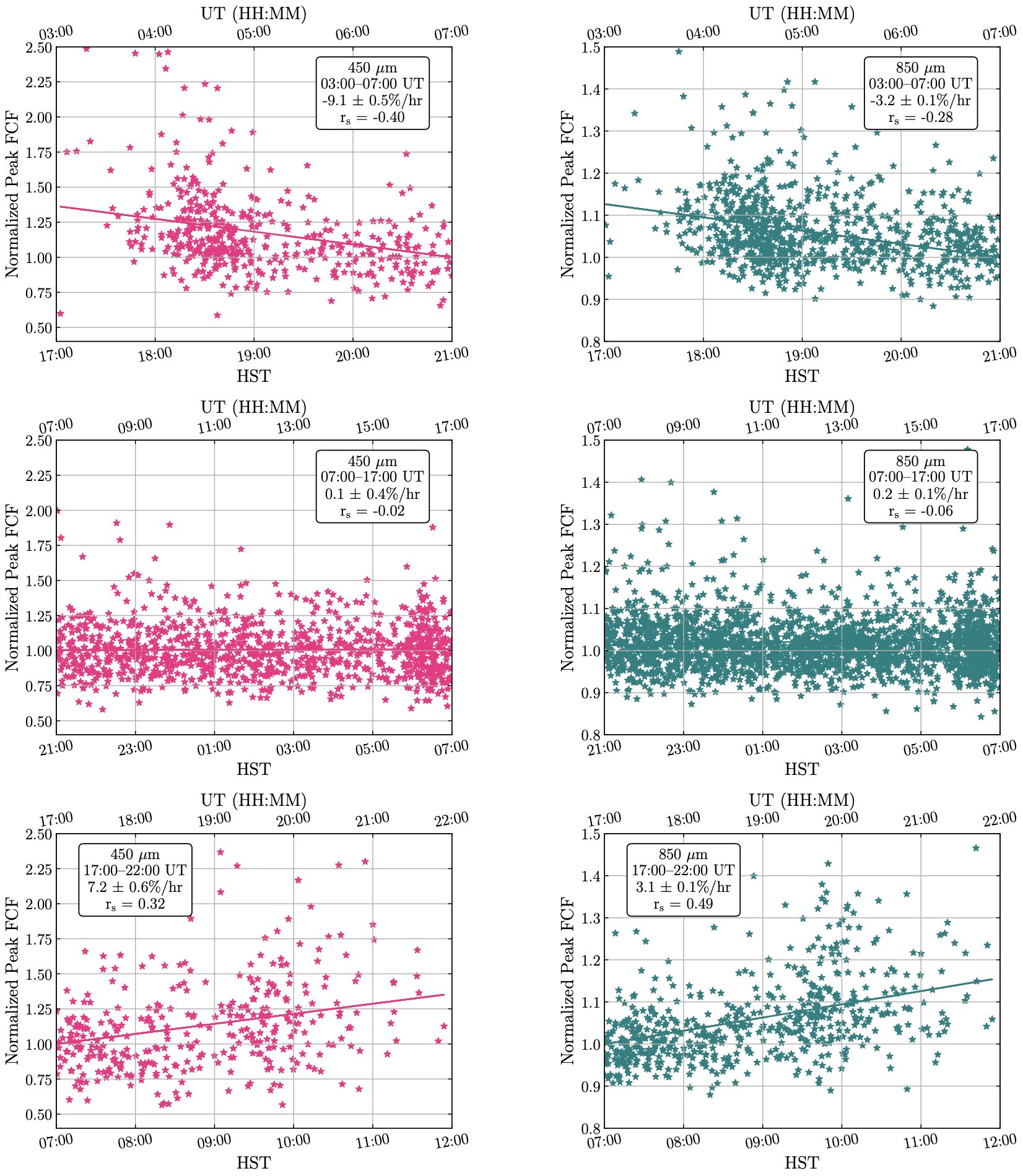
The Peak FCFs DECREASE in the evening as the ambient temperature cools and the dish settles while the Peak FCFs INCREASE in the morning as the ambient temperature warms and the dish becomes unstable to thermal gradients. The following table summarises the rates shown in the figure, above.
| 03:00 – 07:00 UTC | 07:00 – 17:00 UTC | 17:00 – 00:00 UTC | |
| 450 μm Peak FCF | -9.1 +/- 0.5 % hr−1 | No Correction Needed | +7.2 +/- 0.6 % hr−1 |
| 850 μm Peak FCF | -3.2 +/- 0.1 % hr−1 | No Correction Needed | +3.1 +/- 0.1 % hr−1 |
Manual application of FCF and Opacity values
Given the information detailed in the previous two sections, you can assess the impact of the new opacity relations and FCF values on your SCUBA-2 data reduced by Starlink version 2018a by following the steps below. The next release of Starlink (release date TBD) will include the new opacity relations and FCFs derived during the stable part of the night by default. The corrections for evening and morning observations will still need to be applied manually:
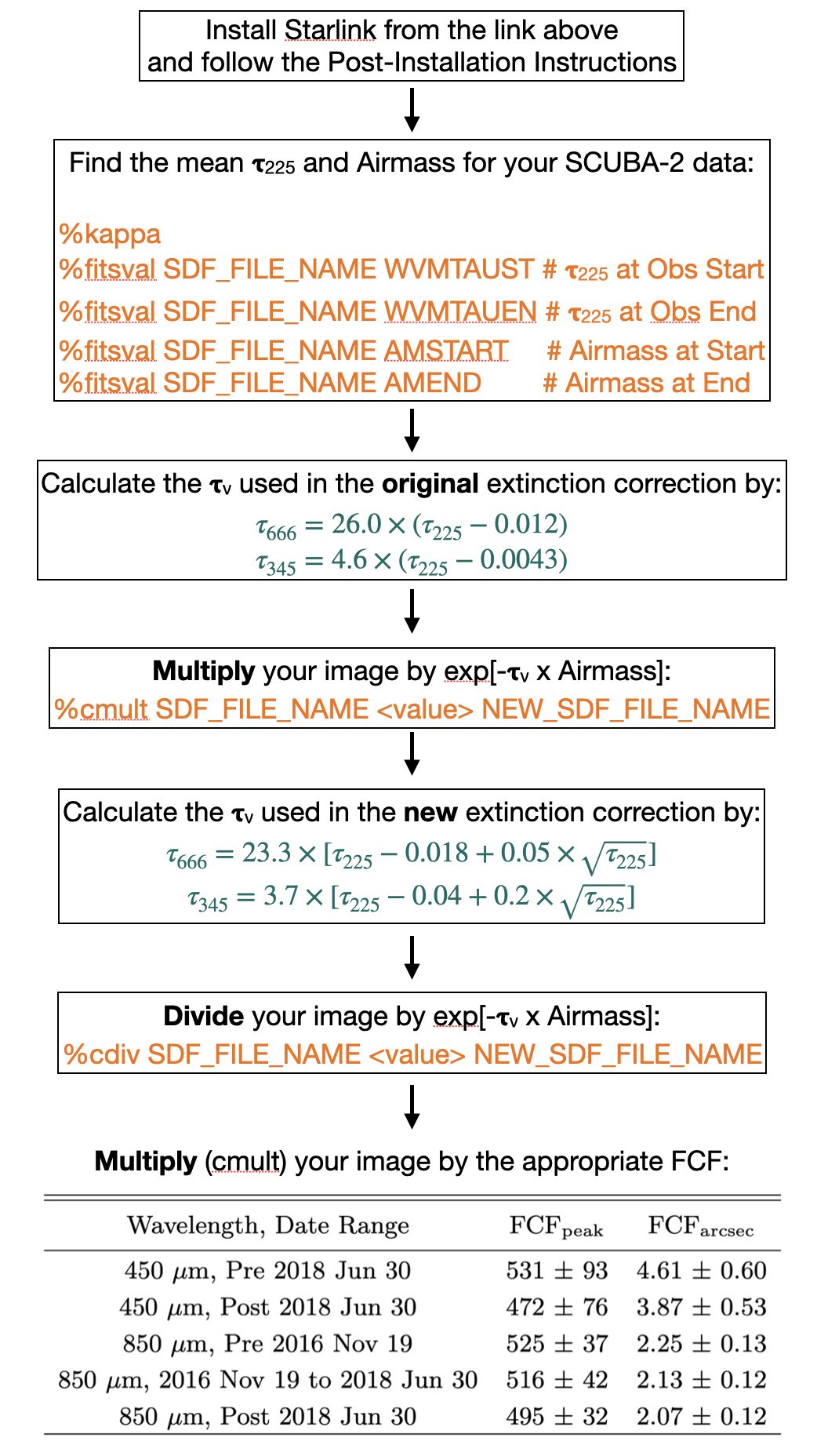
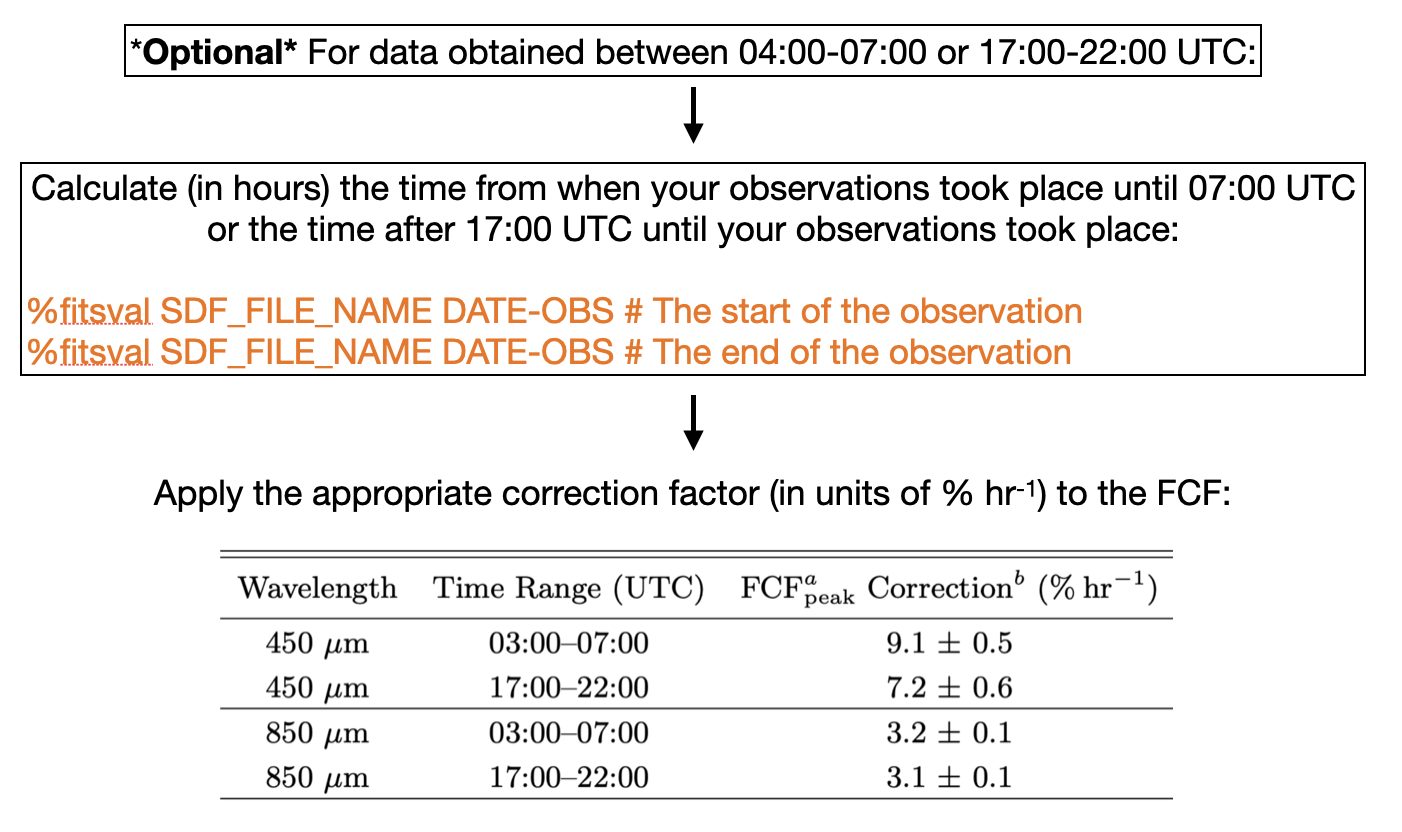
Pixel Size
The pixel size used in the reduction of a calibrator can have a significant effect on the FCF derived. The effect is different for both the beam and aperture FCFs, and also for different calibrators. Below are a series of graphs of the three most commonly-used SCUBA-2 calibrators: Uranus, CRL2688, and CRL618, which together make up over 70% of SCUBA-2 calibrations. A collection of ~20 observations of each calibrator were chosen where the weather was Grade 1 and transmission was 30% or higher at both wavelengths. These calibrations were reduced at pixel sizes ranging from 1 to 8 arcseconds, the FCFs measured, and the results plotted.
The solid blue line marks the standard FCF quoted in Dempsey et al. 2013, with the dotted blue lines marking ±5% variation at 850µm and ±10% at 450µm (beam FCFs typically scatter more than aperture FCFs, due to greater sensitivity to things like telescope focus and shape of the dish). At larger pixel sizes (~5 arcseconds) the SCUBA2_CHECK_CAL recipe can no longer determine beam FCFs for CRL618 and CRL2688 at 450µm, and thus they do not appear on the graphs.
Match-Filtering
The SCUBA2_MATCHED_FILTER recipe can be applied to data to help locate sources the size of the beam while suppressing residual large-scale noise. Applying a matched-filter to calibrators causes a small change of ~2% to beam FCFS, as seen in the graphs below which show the beam FCFs calculated using Uranus (a true point source) using the 1-arcsecond pixel results before (x-axis) and after (y-axis) having a matched-filter applied.
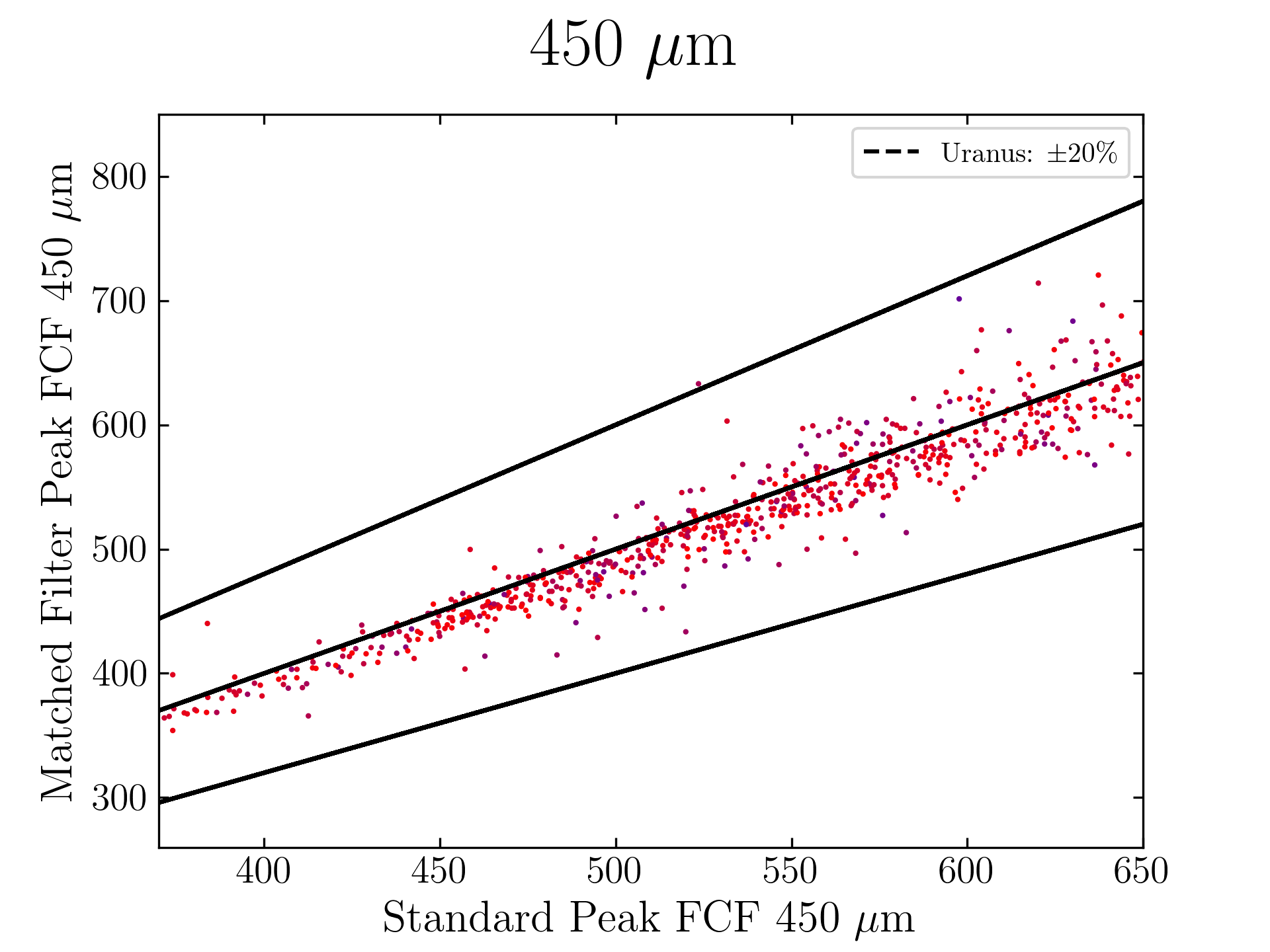
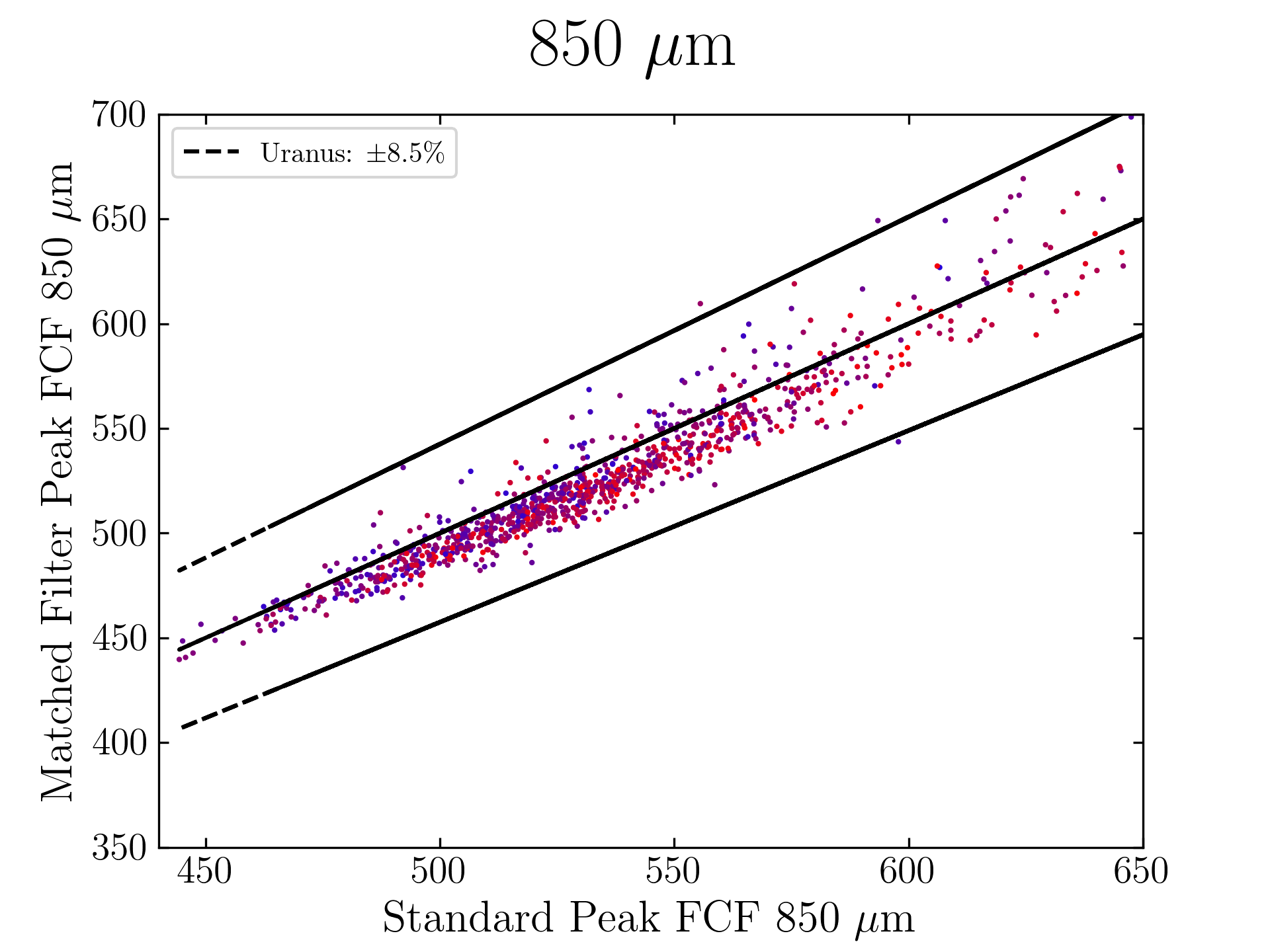
The black lines show the 1:1 relationship and uncertainties of 20% at 450 microns and 8.5% at 850 microns. The points are coloured according to the relative atmospheric transmission during the observation: blue is very high atmospheric transmission while red is low atmospheric transmission. There seems to be no significant trend in atmospheric transmission. All data obtained between May 1, 2011 and Feb 1, 2021 with transmission values better than observing at 30 degree elevation in poor Grade 2 weather (Tau at 225GHz = 0.08; minimum atmospheric transmissions are approximately 49% at 850 microns and 3% at 450 microns) are included in these calculations. While the matched filter only underestimates the standard FCFs by 2%, if you are concerned your results will be affected, we recommend that you apply the same matched-filter you use on your data to the calibration observations obtained for your project in order to derive FCF ratios (matched filter FCF:standard FCF) to compare with these results, above. More information about deriving your own FCFs is given below.
Starlink 2021A Matched Filter Change
As of July 1st, 2021, executing the matched-filter method using the Stardev nightly-update (in advance of Starlink software version 2021A) is expected to increase the measured peak fluxes of bright point sources by ~15%. A similar factor may apply to faint point sources in otherwise “blank fields” but requires further testing.
The plots, below, show comparisons between the 2018A Starlink and the most recent Stardev (anticipating the 2021A Starlink release) matched filter implementation on Uranus calibrator observations taken between 2016-11-01 and 2021-04-13. Note that the Stardev version consistently returns peak flux values that are ~15-20% higher than before due to updated empirical beam measurements presented in Mairs et al 2021. See this software blog post for more information.
Previously, it has been common practice in cosmology publications employing “Blank Field” data reduction recipes (e.g. REDUCE_SCAN_FAINT_POINT_SOURCES, REDUCE_SCAN_FAINT_POINT_SOURCES_JACKKNIFE) to apply a correction factor of ~10% in order to compensate for flux lost due to filtering. This 10% factor was derived by inserting a bright Gaussian point source into the raw power versus time stream of individual observations and measuring the response of the model to the filtering during the data reduction process (e.g. Geach et al. 2013, Smail et al. 2014). We recommend repeating this experiment with the new Stardev (soon to be Starlink 2021A) matched-filter implementation for your specific data in order to determine whether the correction factor is still necessary.
450 microns
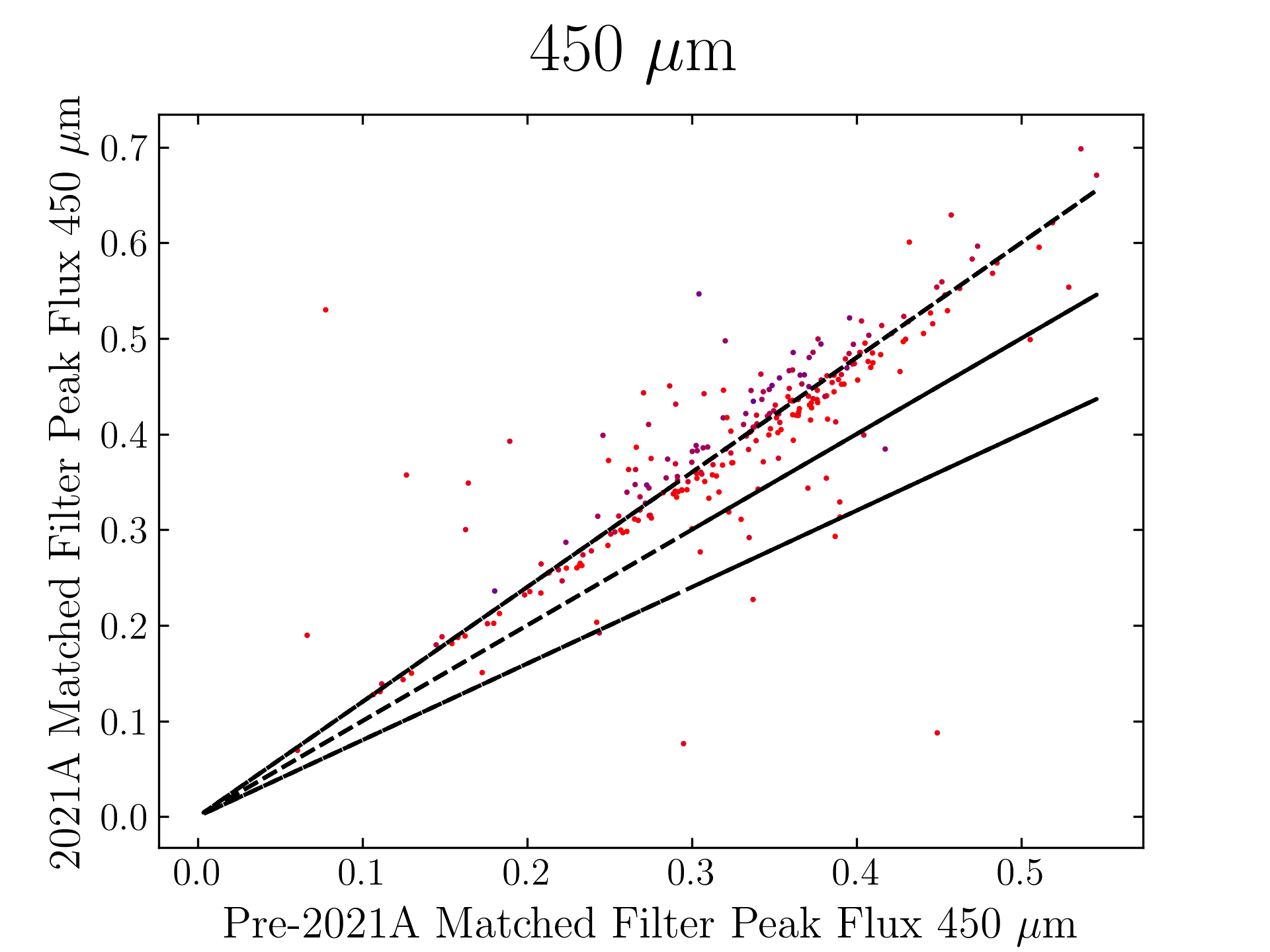
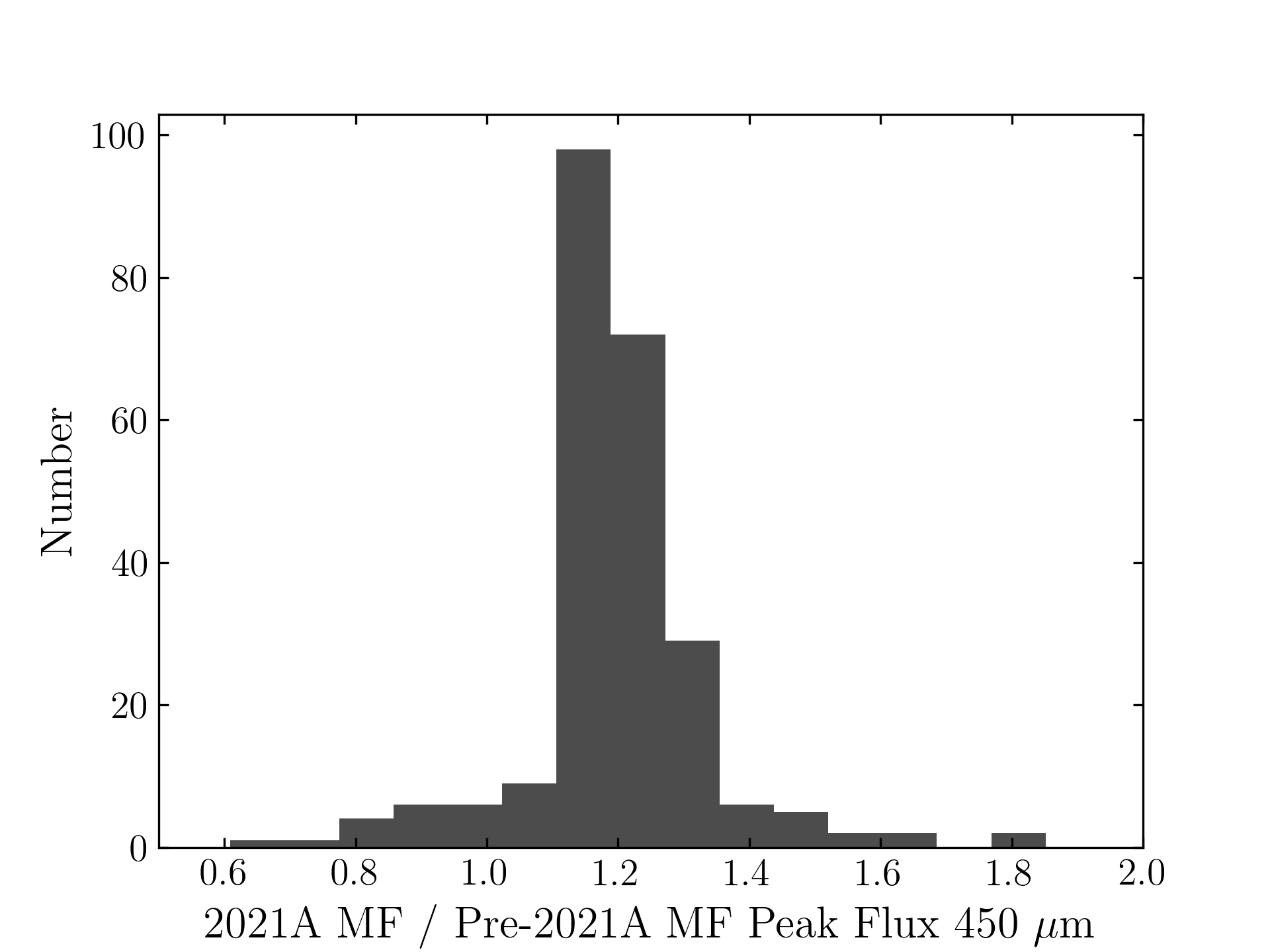
850 microns
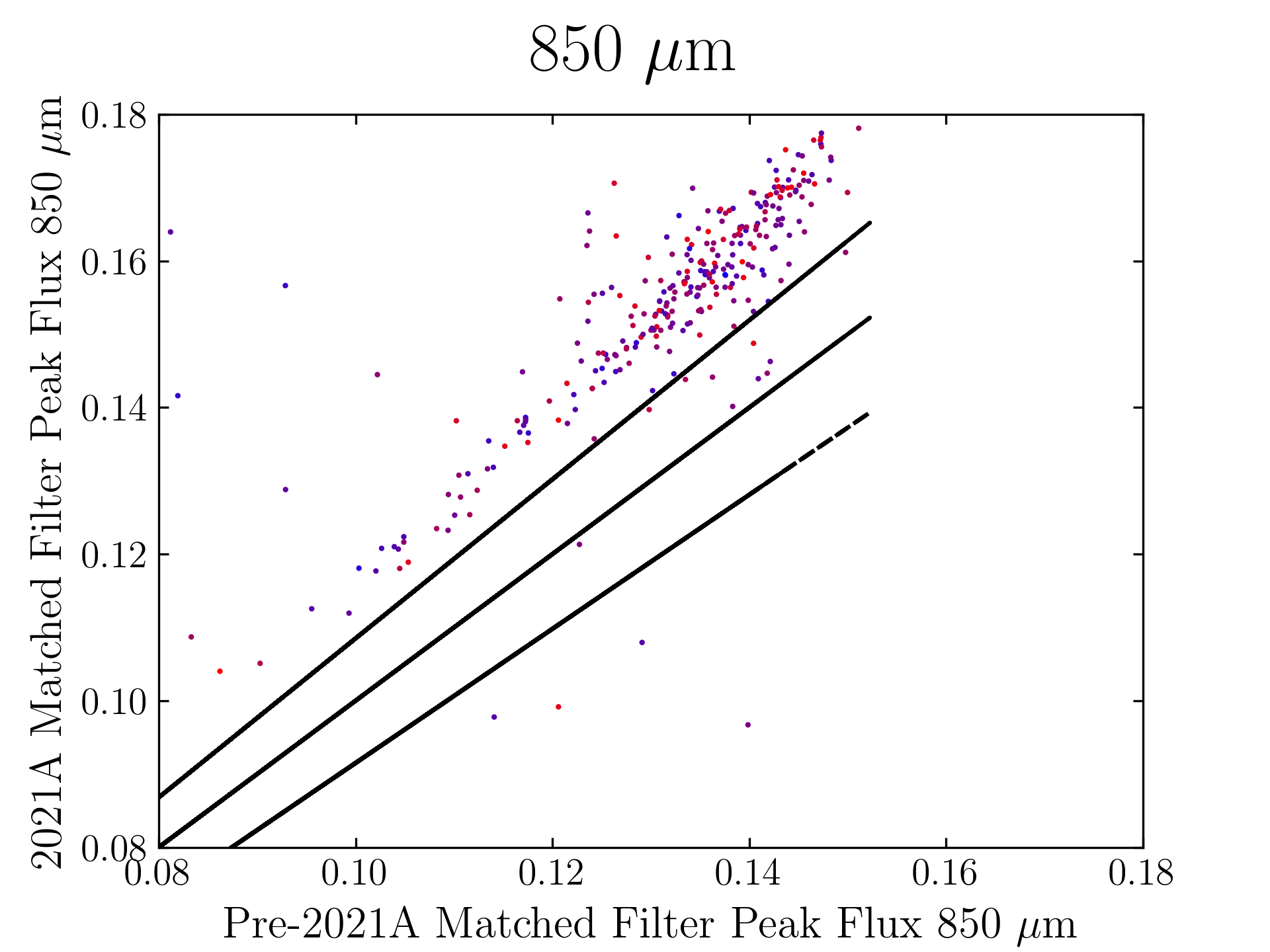
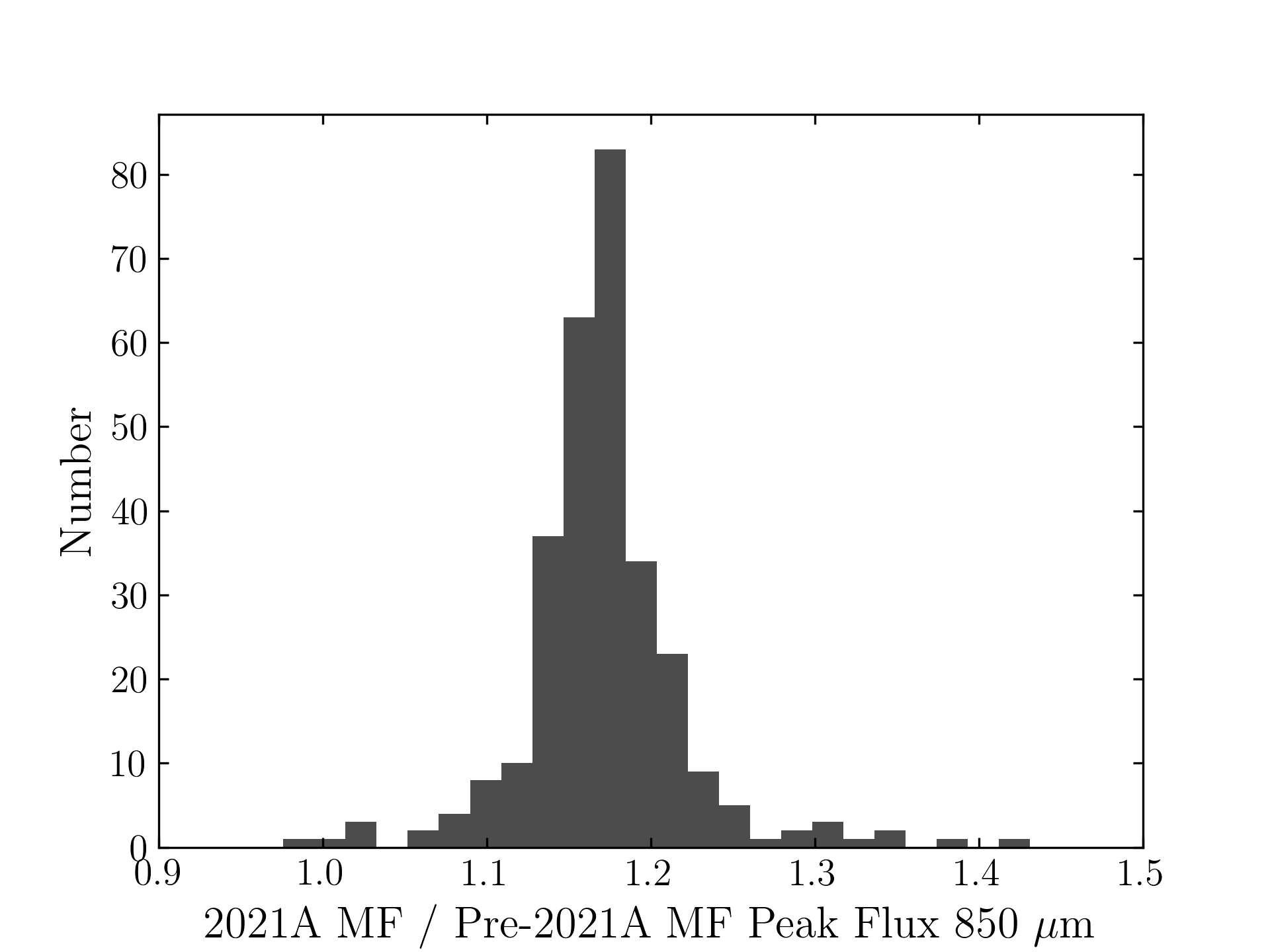
SCUBA-2 Calibration Database
The SCUBA-2 calibration database is a web-accessible database of SCUBA-2 calibrations that exists to allow JCMT users to easily determine the calibrations taken on nights where their projects were observed between May 2011 and October 2017. Searches can be done either by date (single dates or ranges) or by project, which will automatically return calibrations from all dates where the selected project was observed. The database and web interface are currently in a functional if not especially user-friendly state, but several improvements, additional features, and an expansion of the dates included are planned for the future.
Historical Recommended FCF Values
From 2013-2021 the recommended FCF values were constant, based on the results of Dempsey et al (2013). These values are based on the following opacity relations:
(450 microns)
Tau_666 = 26.0 x (Tau_225 – 0.012)
(850 microns)
Tau_345 = 4.6 x (Tau_225 – 0.0043)
| 450 μm FCF | 850 μm FCF | |
|---|---|---|
| Beam | 491 +/- 88 Jy beam−1 pW−1 | 537 +/- 43 Jy beam−1 pW−1 |
| Arcsec | 4.71 +/- 0.9 Jy pW−1 arcsec−2 | 2.34 +/- 0.1 Jy pW−1 arcsec−2 |
A Note About FCF Units
Multiplying the brightness values of a reduced image in units of picoWatts by the Peak FCF will result in a map calibrated in units of Jy/beam. If one instead multiplies the brightness values of a reduced image in units of picoWatts by the aperture FCF, the map will be calibrated in units of Jy/arcsec2. For a point source, the measured peak in a map with units of Jy/beam is equivalent to the integrated total flux of the same source in a map with units of Jy/arcsec2.
To determine the total flux of a point source, we integrate over a 60″ diameter aperture centered on the source calibrated in Jy/arcsec2, then multiply by the area of a pixel in arcsec2 to yield an answer in units of Jy. A background flux value can be subtracted for a more accurate result (see the image below and Dempsey et al. 2013. MNRAS 430:3524.)
An observation of Uranus with 60″ (blue), 90″, and 120″ diameter apertures overlaid. The 60″ aperture encompasses the large majority of the source flux (the excess emission outside this aperture is very faint relative to the peak brightness and can be considered negligible) while the area between the 90″ and 120″ apertures is used to calculate the background flux.
In order to measure the peak flux in a map calibrated in Jy/beam, careful attention must be paid to the fit parameters. Below are 3 histograms comparing the measured total integrated flux in a map calibrated in Jy/arcsec2 with the measured peak flux in the corresponding map calibrated in Jy/beam. The peak flux was measured using the KAPPA command BEAMFIT, fixing the 2D gaussian fit to be symmetric with the FWHM indicated in the title. Note how varying the width of the Gaussian can cause either an overestimate or an underestimate of the total source flux measured by the 60″ aperture
Investigating FCFs for yourself
Previous advice was to calculate your own FCF values using a calibrator closest to your science data (in both time and space). It has been noted, however, that significant outliers can skew your data if you are using a limited number of data points. Therefore, the recommendation is to use the standard values unless you are using a large pixel size (>4 arcseconds) or you are concerned that your matched-filter observations have a flux calibration significantly different from the standard values that you’d like to perform your own analysis.
It is recommended that data is reduced using the latest version of the STARLINK software. Both science and calibrator data should be reduced at the same time using the same configuration file and same pixel size. The process outlined below will yield several FCF values in a log.calstats file created in the directory in which it is run. Peak FCF values are listed as “FCFbeam” while Aperture FCF values are listed as “FCFasec”.
A few quick notes: The FCF values calculated should fall within 15-20% and 5-10% of the standard values at 450 and 850 microns respectively. If the FCF values calculated differ wildly this is likely due to the configuration file. As a first step re-reduce your calibrator with the dimmconfig_bright_compact.lis file and re-run the PICARD command. If your FCF’s still come in outside this 10% and 5% range contact your Friend of Project (FOP). If displayed, the calibrator reduced with the science configuration file may look awful (i.e. show deep negative bowling), but due to the profile fitting picard SCUBA2_FCFNEFD will make a reasonable estimate of the FCF. Be aware that the FCF for daytime observations, or for observations made within 2-3 hours after sunset are higher than those for nighttime observations.
To demonstrate, we’ll run the routine on an already-reduced calibration observation named s20131227_00013_850_reduced.sdf., which happens to be an observation of Uranus. The command to do so is
> picard -log sf SCUBA2_CHECK_CAL s20131227_00013_850_reduced.sdf
This will then produce a lot of output, which we’ll go over in sections. The first section looks like this:
Setting up display infrastructure (display tools will not be started until necessary)...Done
Picard Says: Pre-starting mandatory monoliths...Done
Checking for next data file: /export/data/dberke/tmp/s20131227_00013_850_reduced.sdf
Storing: s20131227_00013_850_reduced
Picard Says: Creating temporary bad observation rules file
A new group 20131227#-1 has been created
Overriding PICARD instrument class to PICARD_SCUBA2_850
Sorting Groups
REDUCING: s20131227_00013_850_reduced
Using recipe SCUBA2_CHECK_CAL specified on command-line Processing data for URANUS
Calling _UNCALIBRATE_SCUBA2_DATA_: undo calibration of given dat
File s20131227_00013_850_reduced already contains uncalibrated data
This first section is picard setting up the file to work on and selecting the correct parameters to use.
Calling _CROP_SCUBA2_IMAGE_: trim image to specified map size
Trimming image to specified map size
Output image will have WIDTH=150 HEIGHT=150 arcsec
This section shows the recipe cropping the image to 150 arcseconds on a side, centered on the calibrator. The default behavior is to measure the flux within a circle with a radius of 30 arcseconds. The noise in the image is measured in an annulus outside the central circle with an inner and outer radius of 45 and 60 arcseconds, respectively. See the image below for a visual representation:
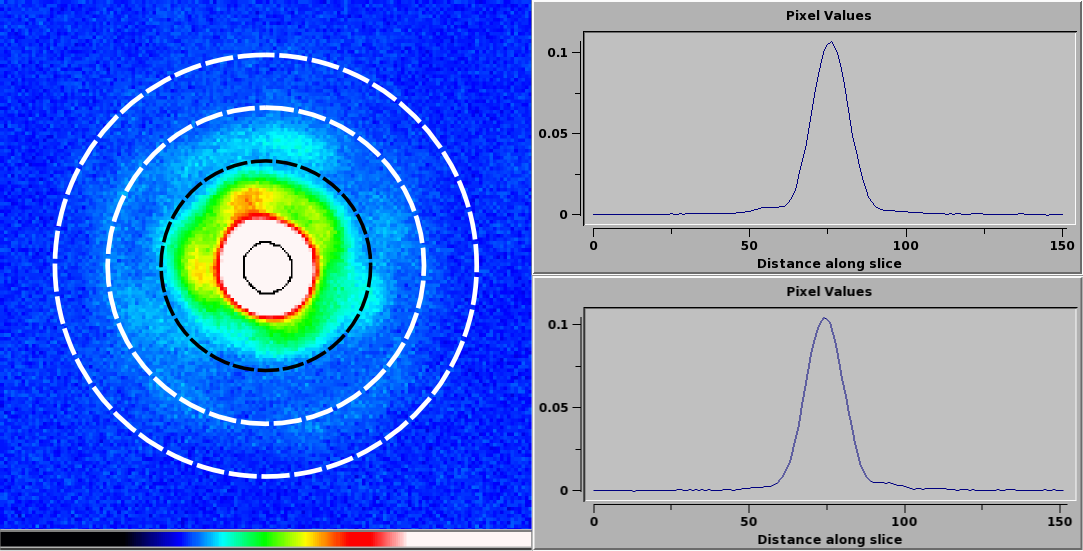 The inner dashed black circle is where the flux is measured, while the annulus defined by the two dashed white circles shows the area where the noise of the image is measured. The two profiles on the right show cuts across the full image, both horizontally (top) and vertically (bottom). The solid black ring in the middle of the image is a contour at 50% of the beam strength.
The inner dashed black circle is where the flux is measured, while the annulus defined by the two dashed white circles shows the area where the noise of the image is measured. The two profiles on the right show cuts across the full image, both horizontally (top) and vertically (bottom). The solid black ring in the middle of the image is a contour at 50% of the beam strength.
Calling _SCUBA2_FIND_BEAM_SIZE_: determine beam parameters
Deriving the beam in the AZEL coordinate system using BEAMFIT
Fitting beam to s20131227_00013_850_reduced_crop
Beam size: 14.39 x 13.52 arcsec^2 at a PA of 37.96 deg E of N (S/N = 180.4)
Error beam fraction = 0.598, 4.9% higher than expected (0.57) at 850 um
This section is where the recipe determines the beam size. The two numbers given after “Beam size” are FWHM slices taken through azimuth and elevation, which allows the calculation of the orientation (given by the Position Angle). The S/N ratio and fraction of the flux in the error beam are also shown here (see Dempsey et al. 2013 for a full treatment of the error beam).
Calling _CALC_SCUBA2_FCF_: calculate an FCF for uncalibrated SCUBA-2 data
Calculating FCF for s20131227_00013_850_reduced (URANUS)
Calculating FCFs for URANUS:
Finding map peak and total flux...
Fitted peak at 0:00:00.000, 0:00:00.00
Plotting image profile + 2-d fit for data map...
Finding peak in matched-filtered map...
Fitted peak at 0:00:00.017, 0:00:00.0
Plotting image profile + 2-d fit for matched-filtered map...
SCUBA2_CHECK_CAL uses different fits to determine the beam parameters and the FCFs. This section simply shows the process of finding the fit for the FCF.
Determining FCF of type ARCSEC:
Flux = 63.6506; Data = 26.911 pW arcsec**2
Storing new FCF for 850: 2.365 +/- 0.001 Jy/arcsec**2/pW (cf 2.34: 1.1% higher)
This section of the recipe shows the calculation of the aperture (or arcsec) FCF. The FCF is calculated like so:
where S is the known flux in Janskys, I0 is the measured signal in pW, and A is the pixel area in arcsec2.
Determining FCF of type BEAM:
Flux = 62.1037; Data = 0.108763 pW
Storing new FCF for 850: 571.001 +/- 1.053 Jy/beam/pW (cf 537: 6.3% higher)
Determining FCF of type BEAMMATCH:
Flux = 62.1037; Data = 0.111419 pW
Storing new FCF for 850: 557.388 +/- 2.442 Jy/beam/pW (cf 537: 3.8% higher)
This section of the recipe shows the calculation of the beam (or peak) and beammatch FCFs. Both are calculated similarly; for brevity only the beam FCF calculation is shown.
The beammatch FCF is calculated using a forced fit to the data, which is why the “data” number it uses is slightly different to the one used for the beam FCF.
Using ARCSEC/BEAM FCF ratio to derive beam area:
derived = 241.44 arcsec^2/beam / FWHM = 14.60 arcsec
empirical = 229.75 arcsec^2/beam / FWHM = 14.24 arcsec
Derived beam area is 5.1 % higher
This section of the recipe shows the empirical and derived beam area and FWHM. The beam area is the ratio of the beam FCF to the aperture FCF:
while the FWHM is calculated from the beam area using the following equation:
The empirical beam area and FWHM are calculated using the standard FCF numbers from Dempsey et al. 2013.
Calling _CALIBRATE_SCUBA2_DATA_: calibrate data using standard, given or derived FCF
Picard Says: Calibrating data in mJy/beam
Multiplying s20131227_00013_850_reduced_crop by 537000 mJy/beam/pW
Calling _CALC_NOISE_: calculate noise in image
Calling _SCUBA2_MATCHED_FILTER_: apply a matched-filter to reduced SCUBA-2 maps
Creating PSF image, normalizing, smoothing and subtracting from original: done
Applying matched filter to s20131227_00013_850_reduced_crop_cal,
smoothing and subtracting from original: done
Re-Calculating NEFDs for current Frame map...
Calling _WRITE_CHECKCAL_LOGFILE_: write flux/nefd/fcf info to log file
Writing results to log file, log.checkcal... done
Calling _WRITE_CALSTATS_LOGFILE_: write logfile with results from calibrator analysis
Recipe took 31.701 seconds to evaluate and execute.
Picard processing complete
Processed one recipe which completed successfully
Exiting...
Picard Says: Goodbye
The remainder of the recipe involves calibrating the image, applying a matched filter to smooth the resulting image, and writing out the results to various log files.



